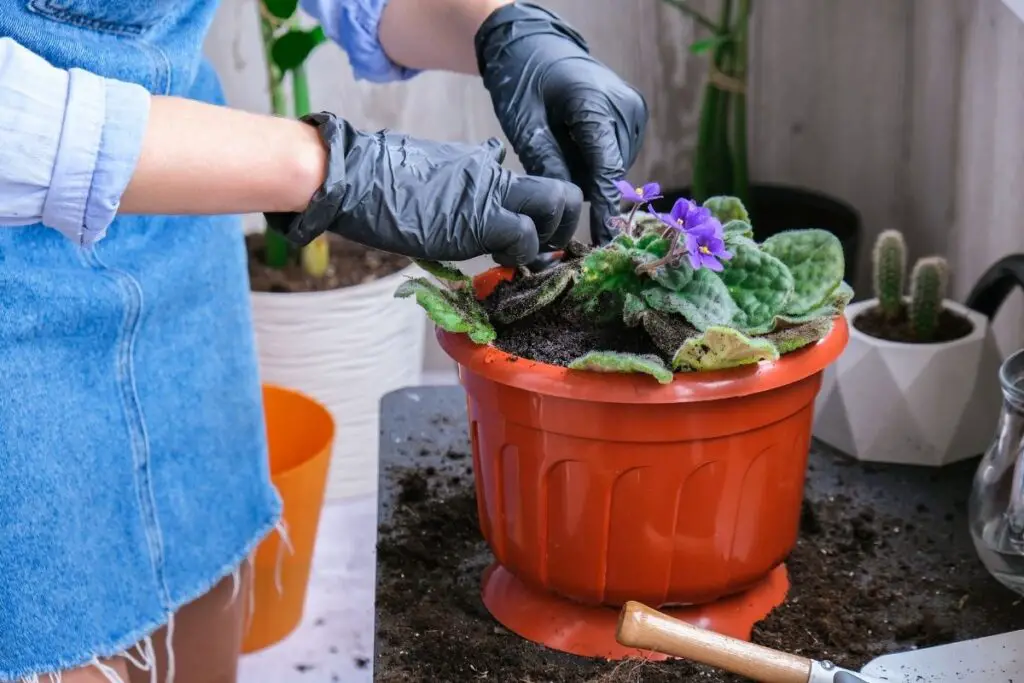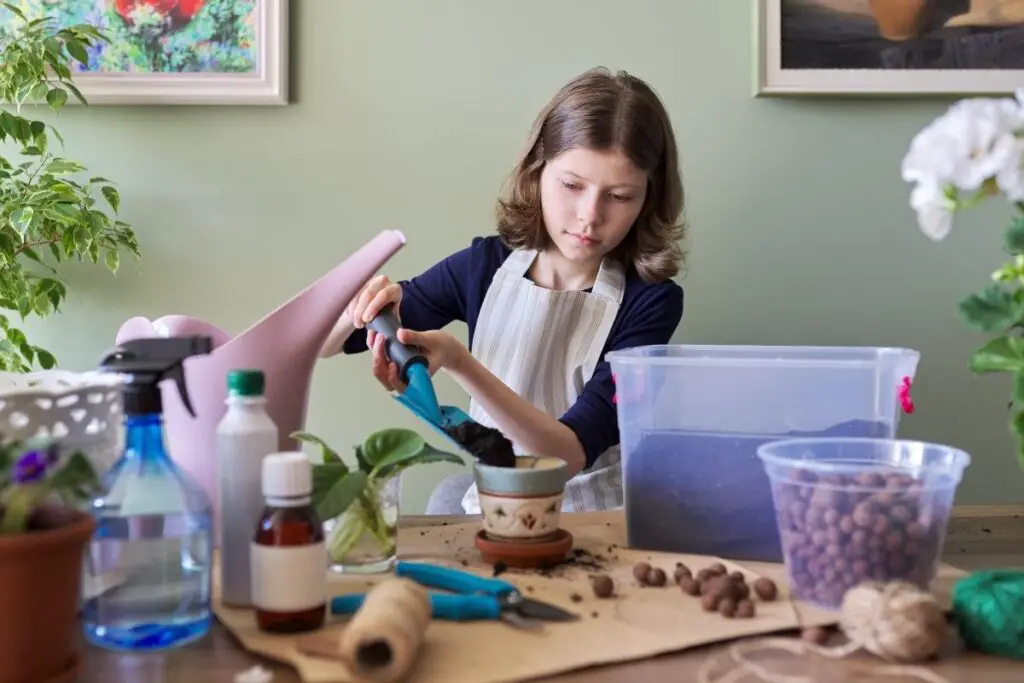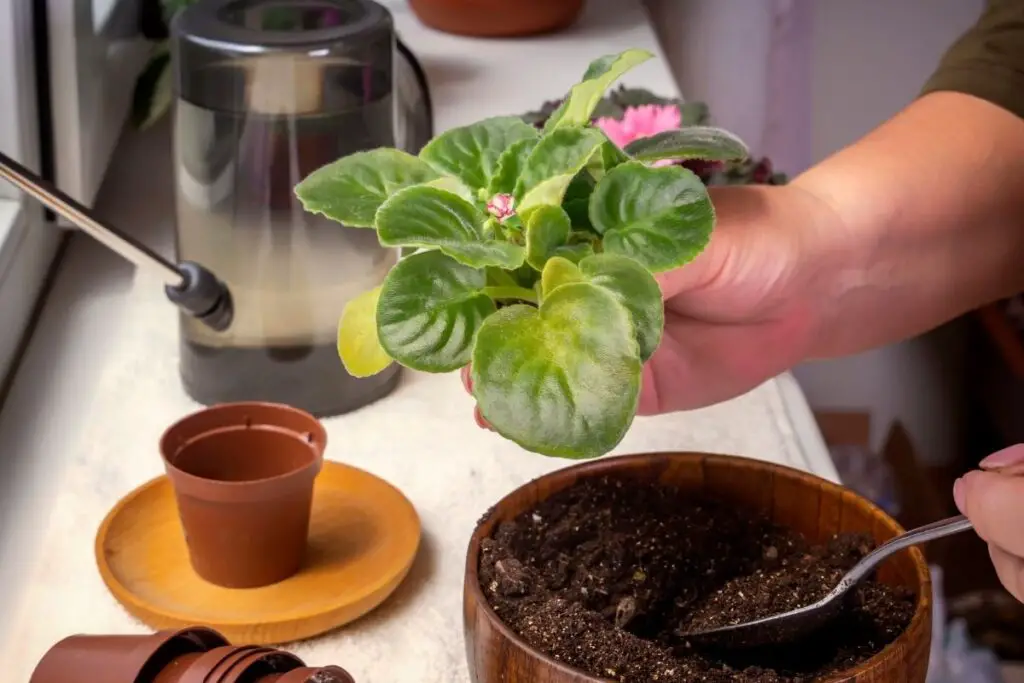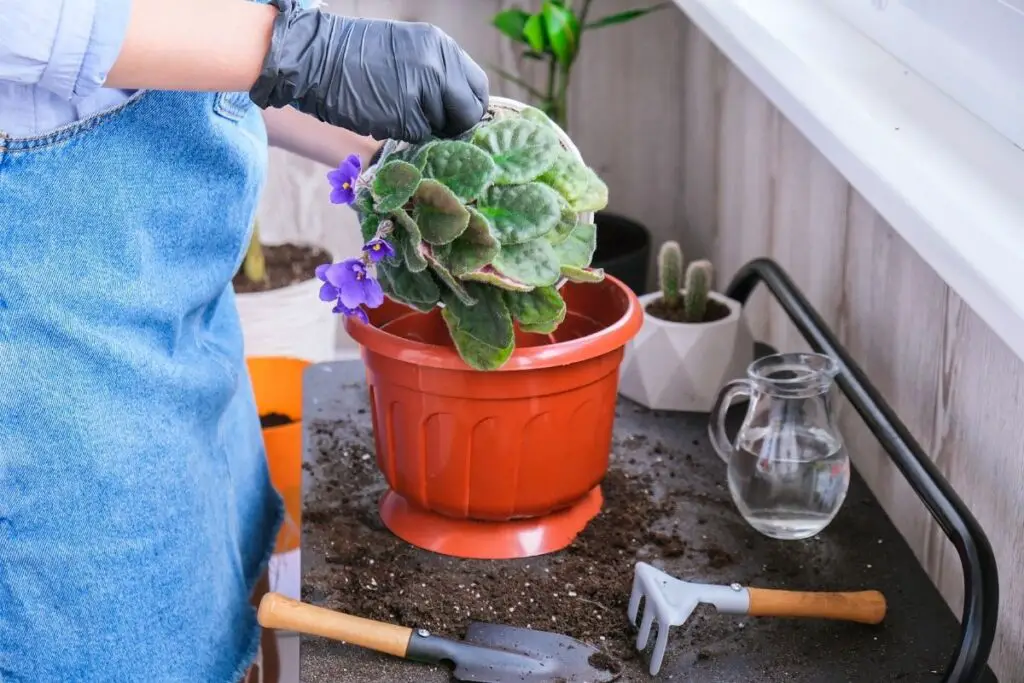Soil always plays an essential role in the growth of plants. If you are growing African violets in your garden, you need to know all the soil requirements if you want them to keep thriving well throughout the year.
So, in this article, we shall discuss what kind of soil is best for African violets and we will also help you make some good soil mix for your African violets.
African violets grow best in light, porous, and well-draining soil. Make a soil mix using peat moss, vermiculite, perlite, and compost to create a well-balanced growing environment for your African violets. The soil should hold the moisture, but it shouldn’t remain soggy at all times.
If you are growing African violets for the first time, keep reading this article to learn about their suitable soil and its importance. We will also help you with knowledge regarding some soil mixes that are ideal for these plants.

Importance of making the right soil choice
Before you plant African violets in your garden, you need to know why it is essential to choose suitable soil for them. Making the wrong soil choice can put your plants in a lot of problems.
When the African violets grow naturally in their native habitat, they grow well and bloom throughout the year because they receive all the essential nutrients from Mother Nature.
But when you are planting them in your garden, the surrounding habitat no longer remains the same as their native land. You have to fulfill all the requirements they are used to in their natural habitat in such a case.
Out of all the requirements, good quality soil is a must. Only garden soil will not work, and you need to amend the soil quality by adding the correct components to the soil.
While choosing the soil, you need to keep certain things in mind, which might help you pick suitable soil.
- It should have a sound drainage system and, at the same time, should be able to hold enough moisture needed for the plant.
- The soil must provide the plant all the nutrients to keep them strong, healthy, and alive.
- The soil must be porous. It must be aerated and loose enough for the roots to receive enough oxygen and air. The roots need to breathe flexibly and deliver water to the plant.
Symptoms showing that you are using the wrong soil mix
You need to choose the right soil for the healthy growth of your African violets. If by any chance you are using the wrong soil mix, your plant will show these signs:
Droopy leaves
One of the common reasons for droopy leaves in your African violet is that the soil cannot retain enough moisture. It happens when your soil lacks the components, which can retain moisture.
Looking for gardening supplies? We have tested 100's of products before recommending them to you guys. Check out our best pick below:
| Image | Gardening Supplies | Best Price? |
|---|---|---|
 Top
Top Top
Top | Raised Garden Bed Kit | Check On Amazon |
 | XLUX Soil Moisture Meter, Plant Water Monitor, Soil Hygrometer Sensor for Gardening, Farming, Indoor and Outdoor Plants, No Batteries Required | No Results |
 Top
Top Top
Top | 82 Pcs Garden Tools Set and Extra Succulent Tools Set | Check On Amazon |
 | Joeys Garden Expandable Garden Hose with 8 Function Hose Nozzle, Lightweight Anti-Kink Flexible Garden Hoses, Extra Strength Fabric with Double Latex Core, (50 FT, Black) | No Results |
 Top
Top Top
Top | Dual Chamber Compost Tumbler | Check On Amazon |
 Top
Top Top
Top | Sunnyglade Plant Stakes | Check On Amazon |
 Top
Top Top
Top | Organic Cold Pressed Neem Seed Oil | Check On Amazon |
 Top
Top Top
Top | Mighty Mint Gallon :-Insect and Pest Control Peppermint Oil | Check On Amazon |
 Top
Top Top
Top | Scotts DiseaseEx Lawn Fungicide | Check On Amazon |
 Top
Top Top
Top | Jacks Classic 20-20-20 All Purpose Fertilizer | Check On Amazon |
 Top
Top Top
Top | 30,000 Seeds Pollinator Attracting Wildflower Mixture | Check On Amazon |
 Top
Top Top
Top | Survival Vegetable Seeds Garden Kit-Over 16,000 Seeds | Check On Amazon |
Dry soil
Sometimes, if your African violets become dull and do not have shine in them, there is some problem with the soil. The soil becomes dry and starts pulling away from its borders.
The soil might not have any components that will help in retaining the required moisture.
Leaf or flower loss
If your soil has more clay content, it will result in overwatering issues, like soaked leaves, root rot, leaf, and flower loss.
Clay tends to hold excess moisture, which becomes a problem for the plants.
In such conditions, you might need to relocate your plant to another place in your garden, where the soil is in suitable condition and not wet or clayey.
Chlorosis
When the soil you selected for your African violet bed is not able to give all the essential nutrients to the plants, that might result in yellow leaves and sometimes, small leaves.
Even if you provide them the nutrients with fertilizers, still your soil will need to give nutrients to the plant for better growth and strength.
What kind of soil is best for African violets?

If you are planning to grow African violets in your garden, you need to make sure that your garden’s soil doesn’t have much clay content in them.
Clay can hold a lot of moisture for a long time. So it is better to avoid clayey soil for these violets.
African violets need soil with a sound drainage system. The soil must not hold excess moisture. These flowers need to get indirect sunlight throughout the day to grow well.
Choose a site where the soil doesn’t remain wet for a prolonged period, and the bright indirect sunlight can help dry the soil.
You can plant your African violets where the soil is sandy. Sandy soil helps retain some moisture and allows the plant’s roots to receive oxygen and air, promoting healthy roots.
You will also need to check the acidity of the soil bed. These violets like to grow in slightly acidic to neutral soil, and they need a pH level ranging between 5.8 and 6.2.
Choose the ideal spot and make the soil mix accordingly by using various organic components.
Best soil mixes for the African violets
While improving the growing conditions of the African violets, you will need to use sand, peat, coir, compost, vermiculite, and perlite to make it well-draining.
Recipe 1
A soil mix for the African violet with peat moss, compost/vermicompost, perlite, and vermiculite will work great. The ratio should be 1/4 of each component.
- 1 cups of peat moss
- 1 cup of vermiculite
- 1 cup of perlite
- 1 cup worm casting/vermicompost
Preparing the soil with these ingredients will help make the soil well-draining, porous, nutrient-rich, and well-aerated.
Recipe 2
Another soil mix that will work great for the African violets will be a mixture of peat moss, compost, and vermiculite or perlite. The ratio of the soil mix should be 1/3 of each
- 1 cup peat moss
- 1 cup vermiculite or perlite
- 1 cup vermicompost/wormcasting
This will help in making the soil well-draining and porous.
Now, let us discuss the importance of using these components while making a soil mix of the African violets.
Importance of the soil components

Peat moss: It is an essential component needed to improve soil quality. It includes a mixture of tree trunks, leaves, grasses, roots, moss, and stems.
It is used in the soil mix due to its eco-friendly properties and helps retain the right amount of moisture needed for the plant.
It is also acidic, and the pH level ranges between 3.5 and 4.5. It helps in maintaining the acidity of the African violet soil.
Perlite: This is an essential component that is rich in minerals. Adding perlite to the soil mix of these plants helps to increase the porosity of the soil.
It is added with peat moss to improve water retention and water drainage, and it helps avoid waterlog and infestations.
Perlite also helps in good aeration and creates holes in the soil, due to which the plant and the roots can receive enough oxygen and breathe appropriately without any suffocation.
It will not do anything to the soil’s pH level because it is 7-7.5, which is neutral.
Vermiculite: It is another vital mineral, like perlite. Adding vermiculite to the soil of these plants helps in the easy absorption of water and nutrients and helps in retaining moisture.
Vermiculite adds all the essential nutrients- magnesium, potassium, and calcium- to the soil needed for good plant growth, and these help the plant to remain strong and healthy.
Vermiculite also has nothing to do with the soil’s acidity level, and its pH level is the same as the perlite.
Vermicompost: Sometimes, compost is used in place of peat moss. It is a mixture of decomposed organic materials that helps hold the necessary moisture needed for the plant. It also helps in making the soil well-aerated.
Although it is not strong as peat, it is still added to the soil in a small amount because of its qualities. Compost contains essential nutrients needed for the plant.
It also helps in maintaining the acidity of the soil. Its pH level ranges between 6 and 8.
Sand: Sand is added to the soil to improve aeration and water retention, and it helps improve drainage. Providing good aeration helps in preventing suffocation and infestations.
Coco peat: Coco peat can also be used instead of peat moss. These are the coconut husks that can hold water in high amounts, and it works better than peat moss in improving aeration and water retention.
But constant use of coco peat can decrease the aeration. These are less acidic compared to peat moss, and the pH level is 5.
When should I plant African violets?

African violets can bloom throughout the year if they get everything that they need. The ideal time for planting the African violet is February when the weather is neither hot nor cold.
After planting, they will get all the warm and humid conditions during March, which will be ideal for their growth as they enjoy warm temperatures.
Choose an ideal spot in your garden on the northern or eastern side, where they will receive the indirect rays of the sun and will also get protected from the intense rays of the sun during the afternoons of summer, spring and fall.
Dig the soil up to a few inches deep, and add the soil mix you have prepared before planting.
Now plant the violets into the dug holes and gently press the soil to remove all the air bubbles. Do not press too much as that might block the air circulation process.
Ensure watering them well after planting so that the root system can get enough water to adjust with the soil. This will help them to absorb the necessary moisture as well.
When should I divide African violets?
Even though these plants like growing close to each other, after some years, when their density increases, you can separate them for efficient growth.
These plants grow fast and start overcrowding inside the soil.
Instead of eliminating them, you can slowly dig out the plant and rip the new baby plants from the mother plant, carefully divide their tangled roots and then plant them in a separate soil bed.
Remove the plant only after the roots have developed well.
For preparing a planting spot, dig the ground about some inches, use the prepared soil mix in the dug area and plant the baby plants gently.
After planting, water the plants well so that the roots get moisture and absorb nutrients from the soil.
You can add compost or sand to the soil to improve water retention and drainage, and compost will also add nutrients.
Final words
African violets love growing in porous, well-drained soil, which can retain enough moisture for the plants to absorb nutrients.
When you choose a planting spot, make sure that the soil is not clayey. You can add sand to the soil bed to improve both drainage and retention.
Make sure that you make the soil mix recipes ideal for encouraging good growth of the African violets to thrive for a prolonged period.
Also, maintain the acidity level of the soil. Fertilize your plant well every four to six weeks to encourage growth rate and keep them strong and healthy. Provide all the requirements to keep them thriving.
Source: Wikipedia, African violet: Classical breeding, African Violet Society of America, In vitro propagation of African violet, University of Florida, North Dakota State University, The University of Georgia.
